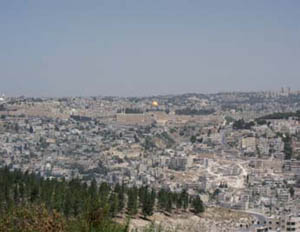 From Film & Digital Times, Issue 35, September 2010
From Film & Digital Times, Issue 35, September 2010
From the Assumption of Mary in “Correggio’s Dome” on page 12, we travel to the actual location in Jerusalem where the scene may have taken place (above, left). We’re at the epicenter of the world’s three major religions, and I’m an accidental tourist with (above, right) Helmut Lehnhof of ZEISS, Alfred Piffl of P+S Technik, Trevor Steele of EMIT, and a group of colleagues attending Band Pro Israel’s Expo and Open House. It’s accidental because I’m in Israel to attend the World i420 sailing championships in Haifa. But plans have been subverted, and here we are bouncing in a bus, like golf balls in a hot and dusty blender, in the place where, for the past two thousand years, the local industry has been holiness.
Is it heat and dehydration that inspires visions and dreams? Curiously, Jerusalem and Hollywood lie close to the same line of Latitude: 32 North. They both face delirium-inducing deserts, and our fantasies drifted to remaking Monty Python’s “Life of Brian” into “The Life of Trevor.” Most attendees of IBC and Cinec know Trevor Steele well enough to appreciate how many pages that epic would consume. In the interest of brevity, we put “Trevor Forever” on hold, and offer instead “The Life of Amnon.”
Once upon a time, in the hot, dusty fields of the small coastal village of Liman, Israel, 3 miles south of the Lebanese border, Miryam was picking cucumbers. “It’s time,” she said to her husband Yehuda.
Five hours later, in June 1957, Amnon Band was born in the hospital at Nahariya, a few miles south. Mom was back at work in the fields the next day. The Band parents were tough people. They had barely managed to survive the Holocaust, returned to Budapest from the camps in Spring 1945, were not welcome by the Hungarian government, and tried to get to Israel in 1948. TheBritish Navy intercepted their boat and sent them to Famagusta, Cyprus. They spent a year in a refugee camp. In 1949, they made it to Israel. The government gave each family two cows, a pre-fab shed and 12 acres of arid land if they settled close to the border. It seems the closer to the border, the more land you got.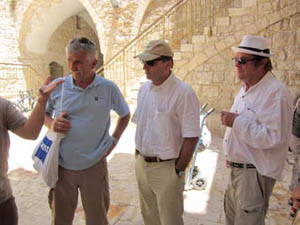
Liman was named after US Senator Herbert H. Lehman. When Amnon began kindergarten, about 60 families lived there. Today, about 170 families raise chickens, grow bananas, mangoes, oranges and avocados, or commute to jobs in Nahariya or Haifa. Each house has a 60 cm thick reinforced concrete bomb shelter.
Amnon now lives in Woodland Hills, CA. Growing up below the Lebanese Highlands was not like living below the Santa Monica Mountains. In Liman, there were deadly snakes that could swallow whole chickens, poisonous lizards, scorpions, and bloodthirsty mongooses. It was a hostile environment, with hostile borders. Until 1965, there was no electricity, no TV, very little water.
By the time he was 10, the family was raising chickens in a noxious chicken coop. The nearby grammar school was a melting pot of mostly European families—Hungarians, Poles, Russians, Romanians, Czechs—but also families who had fled Persia, Libya, Morocco, and Europe. These refugee settlers would later become know as Sabras, like the cactus fruit prevalent there: thorny on the outside but sweet inside (and yes, with lots of pits).
The border was an adventure destination for the kids. They’d take a donkey loaded with chickens up the hill to trade through the barbed wire fence for Lebanese fruits and vegetables. But most of the chickens were sold at markets. The reject chickens were eaten by the family. “Amnon,” his mother would say. “Go get a chicken for dinner.” This did not mean going to the supermarket—it was a hands-on experience. Growing fruits began on a large scale in the 1960s and 1970s with improved irrigation drip techniques. The border with Lebanon was reasonably peaceful up to 1973.
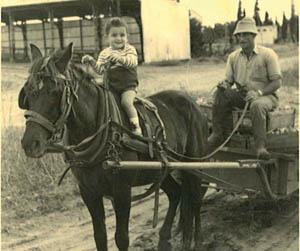 Amnon received a scholarship to study electronics at a prestigious high school in Tel Aviv. His parents wanted him to “get out of Dodge.” He stayed with relatives, a 1½ hour bus ride each way. On weekends, he traveled an additional 3 hours by bus to go home. “This was a big mistake,” Amnon said. “Electrical engineering involved endless hours soldering things. The school was famous for jet fighter engineering.”
Amnon received a scholarship to study electronics at a prestigious high school in Tel Aviv. His parents wanted him to “get out of Dodge.” He stayed with relatives, a 1½ hour bus ride each way. On weekends, he traveled an additional 3 hours by bus to go home. “This was a big mistake,” Amnon said. “Electrical engineering involved endless hours soldering things. The school was famous for jet fighter engineering.”
But he was from a farm; he missed getting dirty. Amnon was rescued by a fortuitous soccer accident. Playing goalie for the home team in Liman, he broke his leg. The cast was too cumbersome for the commute to Tel Aviv. He switched to a nearby school, studied agricultural engineering, geometry, physics and languages. But Amnon was not a model student. He skipped English class—only showing up for the tests.
The next chapter of this story should not be shown to your children. In 11th grade, Amnon told his parents, “I’m bored with school.” They agreed. He took the first bus to Eilat, a resort town on the Red Sea, spending the next three months sleeping on beaches, working with fishermen, growing his hair long.
The hair was shaved in May 1975: drafted into the Israeli Army (almost everyone serves at age 18). Kids recruited in May were notorious: dropouts, rejects, juvenile delinquents, low-lifes—and usually assigned to menial duty. Luckily for him, the officers knew that kids from villages were usually tough. Amnon volunteered on an infantry brigade. After 6 months of active duty, they pulled him out, claiming he was not physically fit for combat. They put him in the supply department of the same brigade, surely a move that would preparep him for supply and demand in later life. After 3 months in the Golan Heights, the colonel said, “Band, we’re trading you to another division. You’re going to work for Yanush.”
Avigdor “Yanush” Ben-Gal was the notorious commander of the Northern Forces. During the War of Yom Kippur in 1973, Ben- Gal commanded the 7th Armored Brigade and oversaw the defence of the Golan Heights under Syrian attack. It was the largest tank battle in history. Yanush Ben-Gal’s heroism and leadership are believed by many as the decisive factor in the conflict.
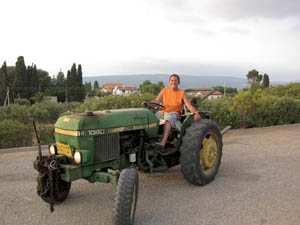 Avigdor “Yanush” Ben-Gal was born 1938 in Lodz, Poland. When Germany invaded Poland, the family fled to Siberia. Yanush’s mother died; his father saved the two children by bribing Polish officials to take the youngsters to safety. The siblings first ended up in Teheran, then were sent to India, and after many adventures and hardships were transported to Israel (then still under British Mandate and called Palestine). They were placed in a kibbutz, like many European orphans escaping the Holocaust, but soon fled to Tel Aviv, where they were raised by a distant relative.
Avigdor “Yanush” Ben-Gal was born 1938 in Lodz, Poland. When Germany invaded Poland, the family fled to Siberia. Yanush’s mother died; his father saved the two children by bribing Polish officials to take the youngsters to safety. The siblings first ended up in Teheran, then were sent to India, and after many adventures and hardships were transported to Israel (then still under British Mandate and called Palestine). They were placed in a kibbutz, like many European orphans escaping the Holocaust, but soon fled to Tel Aviv, where they were raised by a distant relative.
Anyway, Yanush needed a body guard, driver, navigator, and communication expert—and Amnon knew the territory. “It was crazy,” he said. “I was 20 years old. They trusted me to drive the general, chief of staff, and high ranking officials all over the place. We snuck into Lebanon at night. We were shot at, met with double agents; it was way too much responsibility for a kid. I had to make sure he ate well and slept a little (which he did not like). We had a Jeep Wagoneer. It was like a fortress on wheels, with steel plated armor, bullet-proof windshields, lots of weapons, and ammunition. Yanush had a sweet tooth, so we had a little kitchen in the back with candy, chocolate, and toffee. I was a bit crazy about protecting his life; he came from tanks, I came from infantry, so we had many differences of opinion.”
May 1978. Amnon was honorably discharged from the Army. His Dad bought an airline ticket to Los Angeles so he could stay with relatives. February 1979: Amnon arrived in LA. “I never got used to being an Israeli. I always knew there was something else out there. I just didn’t know what it was.”
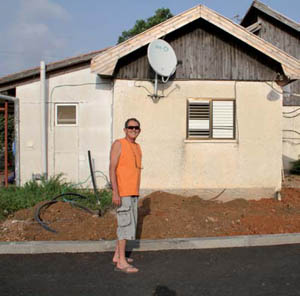 The road to Hollywood and learning about camera equipment began with a job offer at S.I.R. Rentals, which also owned A&S cases (rival of Anvil cases). Positions at G&M Batteries and Jack Pill led to his first camera sale: an Éclair ACL. By the end of 1983, he had increased sales of G&M batteries to the point where Otto Nemenz said, “I hope you’re getting a piece of the company.”
The road to Hollywood and learning about camera equipment began with a job offer at S.I.R. Rentals, which also owned A&S cases (rival of Anvil cases). Positions at G&M Batteries and Jack Pill led to his first camera sale: an Éclair ACL. By the end of 1983, he had increased sales of G&M batteries to the point where Otto Nemenz said, “I hope you’re getting a piece of the company.”
Amnon wasn’t. So in July 1984, with $5,000, he started his own company, called Band 84, selling promotional logo clothing and used equipment. It was at 3507 West Magnolia. I think Otto Nemenz still has the first crimson jacket with the Nemenz logo that Amnon sold him. Anton Wilson took notice, and Band 84 started selling Anton/Bauer batteries. More products followed.
One day, Tony Zaza, who worked at Century Optics, brought in a brochure and said, “You should get into this.” The brochure was from Chrosziel. In September 1984, Amnon went to Munich to meet with Alfred. They got along, and Alfred was impressed how well Amnon knew the equipment. Alfred asked the 27 year old kid to represent the company in the US. That was the 2nd big break for Band. “It was the connection with cinematographers and end-users that made it successful,” Amnon says.
The company was renamed Band Pro in 1985. One day, Greg Pine of Sony said, “You should sell our cameras.” Amnon replied, “How do we do that?” That led to the company’s 3rd big break, in 1986. They established a loaner program, providing backup cameras, lenses, tripods and accessories. Since 1995, Band Pro has been the largest F900 reseller in the world, and the only reseller for F23 and F35. It has been a unique 24-year relationship.
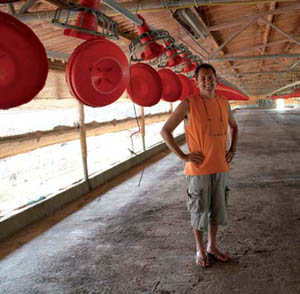 The company grew. In 1986, Band Pro had 3 employees in a 1,000 square foot space. In 1995, they moved to the current location at 3403 West Pacific. Today there are 45 employees worldwide. In 2000, they partnered with ZEISS on the DigiPrime and DigiZoom lenses for 2/3" chip cameras, and opened Band Pro Munich. Over 3,000 DigiPrimes have been sold. In the late 1990s, 16x9 Inc was established to distribute products to dealers as opposed to end users. Recently, upon Otto Nemenz’s recommendation, Band Pro became the worldwide distributor of Leica Summilux-C lenses.
The company grew. In 1986, Band Pro had 3 employees in a 1,000 square foot space. In 1995, they moved to the current location at 3403 West Pacific. Today there are 45 employees worldwide. In 2000, they partnered with ZEISS on the DigiPrime and DigiZoom lenses for 2/3" chip cameras, and opened Band Pro Munich. Over 3,000 DigiPrimes have been sold. In the late 1990s, 16x9 Inc was established to distribute products to dealers as opposed to end users. Recently, upon Otto Nemenz’s recommendation, Band Pro became the worldwide distributor of Leica Summilux-C lenses.
Amnon wraps up: “In 1984, Band Pro basically pioneered the idea of electronic cinematography. In June 1995, we decided to dedicate our entire operation to HD. Everyone, including you, Jon Fauer, thought we were crazy. Almost everything we’ve donea since then was a natural continuation of what we started in 1984. We had to take risks, see into the future, and above all, have passion for what we do.”
